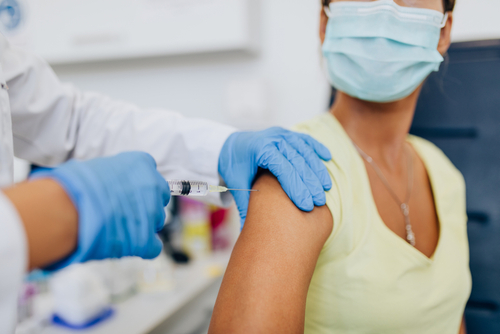November 29, 2021

Deletion mutations may help rapid identification of Omicron. In a technical brief outlining priority action in the face of the latest discovery of the Omicron variant, the WHO outlines that a genetic deletion in the spike protein region may help rapidly identify the Omicron variant. The mutation referred to as Spike Gene Target Failure (SGTF) from a widely used PCR test was also previously identified as a B.1.1.7 variant marker. [WHO], [JAMA].
Low- and middle-income countries lack access to equitable COVID-19 vaccine distribution. A cross-sectional study identified 25 countries that conducted clinical trials for Pfizer, Moderna, Janssen, AstraZeneca, Sinopharm, or Sinovac COVID-19 vaccines. Out of 11 high-income countries that hosted clinical trials, 10 authorized the tested vaccine, vaccinating about half of the population over 15 years. Lower-middle-income and upper- countries had similarly high rates of authorization. However, their vaccination rates were 31% and 14.9%, respectively. Despite countries of varying incomes conducting trials and authorizing COVID-19 vaccines, high-income countries were found to have monopolized vaccine procurement and distribution. [JAMA Network Open]
EWARS is a cost-effective, well-performing component of Ebola surveillance. Early Warning, Alert and Response System (EWARS) for the Ebola virus disease was an Alert Unit made up of an 11-person team implemented in the Democratic Republic of the Congo at the start of the 10th Ebola virus outbreak. The EWARS system tackled 195,601 alerts over about two years, 15.8% of which were validated as suspected cases, and 804 (~2.7%) were confirmed or probable cases. EWARS was found to be a functional and cost-effective strategy for infectious disease surveillance and management. [CDC, Emerging Infectious Diseases]
The threat of antimicrobial resistance has worsened during the COVID-19 pandemic. The COVID-19 pandemic has led to increased production and use of antimicrobials in India. Inappropriate and excessive use of antimicrobials from one of the world’s largest producers and consumers of antimicrobials is of great concern to global health, particularly given the substantial number of highly resistant Gram-negative bacteria present in the region pre-pandemic. To successfully manage this issue, the development of an antimicrobial resistance surveillance system is essential, and both policy revision and improved antimicrobial stewardship are recommended. [Science of the Total Environment]
Only global partnerships can stop antimicrobial shortages and prevent resistance. Access to safe, effective antimicrobials is essential for the prevention of antimicrobial resistance (AMR). While lack of access usually affects low- and middle-income regions, the knock-on effect impacts global health. A recent study identified common drivers for antimicrobial shortages and proposed improvements related to antimicrobial regulation, supply, and cost to improve equitable and sustainable distribution. The authors highlight the importance of establishing global collaborations to monitor AMR trends, diseases, pandemic events, and supply chain issues to forecast and respond to antimicrobial shortages. [BMJ Global Health]
Sub-Saharan HIV programs resilient despite the COVID-19 pandemic. The COVID-19 pandemic affected health services in many countries. An analysis of HIV services in 11 Sub-Saharan countries assessed the pandemic’s impact on these countries’ HIV programs. Data collected between October 2019 and September 2020 indicated a decrease in testing, diagnoses, and the start of antiretroviral treatments early on in the pandemic. However, these initial declines self-resolved and a rebound was observed between July and September 2020. [Clinical Infectious Diseases]
COVID-19 vaccine acceptance in Thailand could increase to 91.3%. COVID-19 vaccine acceptance ranges from 23.6%-97% worldwide. A cross-sectional study in Thailand, where CoronaVac and AstraZeneca vaccines are easily accessible, investigated the willingness of expatriates and Thai people to receive the COVID-19 vaccine. Concerns about vaccine efficacy and side effects were commonly reported. Acceptance rate was found to increase if vaccine brand selection was allowed and when healthcare workers recommended specific brands. Vaccine acceptance in Thailand would likely increase if vaccines with at least 70% efficacy and low rates of side effects became available. [Vaccine]
Three-dose HPV vaccine is safe and effective in young cancer survivors. Young cancer survivors are at increased risk of future HPV-associated cancers. An investigator-initiated, phase 2, single-arm, open-label, non-inferiority trial assessed the immunogenicity and safety of the HPV vaccine in cancer survivors aged 9 to 26. Among the 436 participants who had completed cancer therapy in the past 1-5 years and were given the quadrivalent or nonavalent HPV vaccine, 54% reported side effects, though only one adverse event was serious. The immunogenicity and safety of the HPV vaccine were similar to that of the general population. [The Lancet Child and Adolescent Health]
Geostatistics identifies both lack of access and excess antibiotic consumption worldwide. A spatial modeling study combined geostatistical modeling techniques with data on pediatric antibiotic use to estimate antibiotic consumption between 2000-2018 for 204 countries. Global consumption was estimated to have increased by 46% during this period. Antibiotic use was consistently low in sub-Saharan Africa, indicating lack of access to essential antibiotics. Usage was consistently high in eastern Europe and central Asia, indicating excessive antibiotic use. Increased fluoroquinolone and 3rd generation cephalosporin use was identified in North Africa, the Middle East, and South Asia. [The Lancet Planetary Health]
Concomitant COVID-19 and influenza vaccination are safe and effective. A multicenter, randomized, controlled, phase 4 trial in the United Kingdom assessed the administration of either Astra Zeneca or Pfizer COVID-19 vaccines with concomitant administration of either a seasonal, inactivated influenza vaccine or a placebo. Three weeks after administration, the placebo group received the influenza vaccine and vice versa. Most systemic reactions were mild to moderate, with only one serious adverse event recorded. Immune responses were not adversely affected by concomitant vaccine administration. [The Lancet]
Photo: Shutterstock











